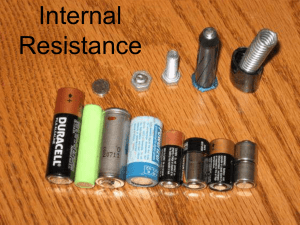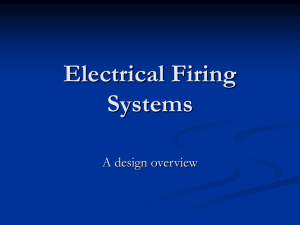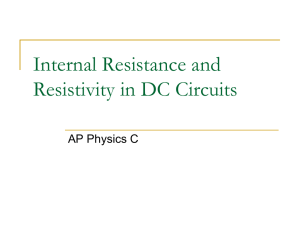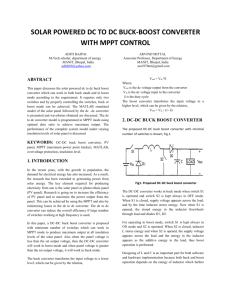Project Progress Presentation(MS PowerPoint Format)
advertisement
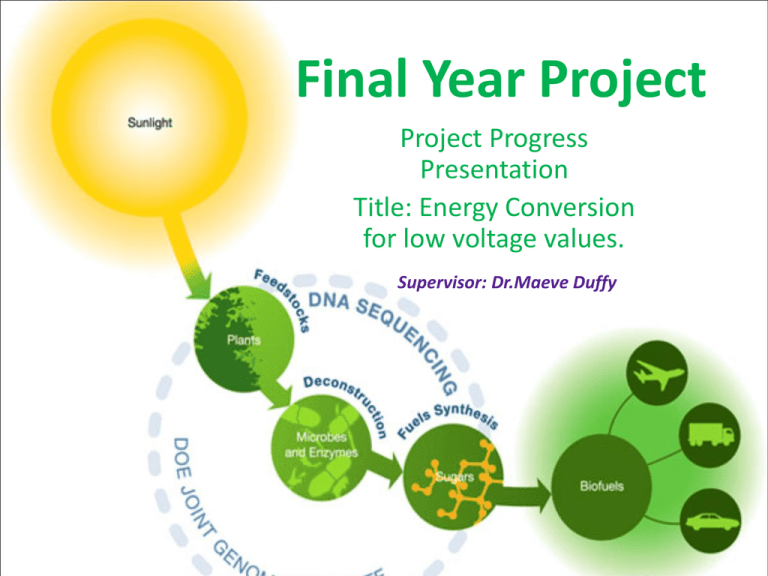
Final Year Project Project Progress Presentation Title: Energy Conversion for low voltage values. Supervisor: Dr.Maeve Duffy Aim of Project The aim of this project is to develop circuits to demonstrate the performance of bio fuel cells which are being developed by the Energy research centre in NUI Galway. The ideal end goal would be where a microbial fuel cell arrangement has the ability to charge a mobile phone battery. Outline of Presentation This presentation will deal with the following topics: 1. 2. 3. 4. 5. Overview of Project Progress to date Project Plan Time Management Questions 1) Overview of project: 2) Progress To Date: • • • • Thévenin equivalent circuit LED Demonstration Low power devices identified Demonstration of fuel cell powering low power devices • Research of charging algorithms Thévenin Equivalent circuit: 0.6 1200 0.5 1000 0.4 800 0.3 600 0.2 400 0.1 200 0 0.05 0 0.1 0.15 0.2 0.25 0.3 Current density (mA/cm2) 0.35 0.4 Power density (mW/m2) Voltage (V) Power Density curve: Blue line represents the power density Vs current density. White line represents Voltage Vs current density . Area across which power density is measured is 5.4cm^2. 1cm^2 = 0.0001m^2 The point at which we have maximum power output is the second from right so we take this point. When worked out the following outputs result: Power ~ 0.486 milli-Watts Voltage ~ 0.42 volts Current ~ 1.215 milli-Amps Internal Resistance of Fuel Cell ~ 345 ohms Thévenin Equivalent circuit: LED Demonstration: On testing the LED’s found in the electronics labs it was found that the lowest power LED needed a minimum of 3.8 milliAmps and a minimum of 1.83 volts to light. This meant the voltage & current output from the fuel cell needed to be stepped up. There is three solutions to this problem: 1) Cascade a number of fuel cells in parallel, this way increasing the current output and then use a DC-DC boost converter to step up the voltage. 2) Use an RC circuit to boost the current using a mosfet to sfor switching and then use a DC-DC boost converter to step the voltage up. 3) Order a low power LED (1 milli-Amp LED can be obtained) Low power devices identified: Voltage needed: 1.5 Volts DC Power needed: 0.0001 Watts Current needed: 66.66 microAmps Voltage needed: 5 volts DC Power needed: 0.9 Watts Current needed: 0.18 Amps Voltage needed: ~5 volts DC Power needed: unknown Current needed: unknown Demonstration of fuel cell powering low power devices: To demonstrate these devices a DC-DC boost converter needed to be designed. This caused problems as most common DC-DC boost converters use either diodes or BJT’s which have a diode between the base and emitter. The BJT is used due to its fast switching speeds. The diodes cause a minimum of 0.3 voltage drop. As the output voltage from the fuel cell is so low already we can not afford to use BJT’s. Demonstration of fuel cell powering low power devices: Using a boost converter obtained from Texas instruments called the TPS61200 I am currently trying to boost the output voltage of the fuel cell enough to allow me to power one of the low power devices mentioned above. This converter gets around the problem of using BJT’s by using MOSFET’s instead. The TPS61200 can needs 0.8 volts to startup, after which it can operate at a voltage as low as 0.3 volts. As the TPS61200 was to small to fit on a board I needed to order the evaluation module. Demonstration of fuel cell powering low power devices: Demonstration of fuel cell powering low power devices: Demonstration of fuel cell powering low power devices: Demonstration of fuel cell powering low power devices: From using the formula to work out the minimum inductance needed (Vin = L * DI/DT) ,I found that the minimum inductance required was 2.1333 micro-Henry’s. So the 2.2 micro-Henry should be satisfactory to induct the input current from the fuel cell. Research of battery chemistries, charging algorithms: Example of type of voltage and current used to charge a phone: My phone (Sony Ericsson) is a lithium-polymer battery which supplies 3.6 volts to the phone. And has 780 milli-Amp hours. The charger for the phone supplies 5 volts and a current of 1Amp. This is probably implementing a charging algorithm known as constant charge where a constant charge is applied to the battery. The type of charging algorithm I will most likely have to implement is trickle charging as it charges the battery with a small current over a long period of time. 3) Project Plan: As identifying a suitable DC-DC boost converter has slowed me down I have revised my project plan as follows: January 22nd: Configure the DC-DC boost converter to power a low power device. February 5th: More research on battery chargers. Design battery charger needed to charge a typical phone battery. February 19th: Either configure TPS61200 to output voltage needed to power battery charger circuitry or identify a DC-DC boost converter which can. March 3rd: Identify a suitable microprocessor to read in voltage across the battery and adjust the battery charger output accordingly and Design a suitable Trickle Charge algorithm. March 6th: Test the circuitry with different loads attached. March 8th: Test the complete circuitry with a rechargeable battery and determine overall efficiency. March 16th: Draft Final Report. March 24th: Submission of Final Report. March 29th: Oral and practical presentation. 4) Time Management: I feel that in the first semester time management also had a role in slowing my progress on the project so this semester I aim to improve on this. This is a quiet tight schedule but I believe if I dedicate Tuesday evenings and Fridays to practical work in the Laboratory as well as any other free time and Saturdays to research I will be able to get it done. 5) Questions!!


